小学英语语法形容词副词
小学英语语法形容词副词的用法总结整理归纳

小学英语语法形容词副词的用法总结整理归纳形容词是用来描述事物的特征和性质的词语,而副词则用来描述动作的方式、程度、时间等。
下面是小学英语形容词和副词的用法总结:形容词的用法:1. 形容词一般置于名词之前,用来修饰名词。
例如:a big house (一座大房子),a happy girl(一个快乐的女孩)。
2. 形容词可以用于比较级和最高级。
比较级用来比较两个事物的不同,最高级用来比较三个或以上事物的不同。
例如:This book is bigger than that one(这本书比那本大);He is the tallest boy in the class(他是班级里最高的男孩)。
3. 形容词可以和"be"动词连用,表示事物的状态或性质。
例如:She is beautiful(她很漂亮)。
副词的用法:1. 副词可以修饰动词,表示动作的方式、程度等。
例如:He runs quickly(他跑得很快)。
2. 副词可以修饰形容词,表示形容词程度的大小。
例如:She is very beautiful(她非常漂亮)。
3. 副词可以修饰其他副词,表示副词的程度。
例如:He reads quite slowly(他读得相当慢)。
4. 副词也可以修饰整个句子,表示说话人的态度或观点。
例如:Certainly, I will help you(当然,我会帮助你)。
需要注意的是,有一些形容词和副词的形式是相同的,需要根据具体情况来判断其词性。
同时,有些形容词和副词可以通过在词尾加上"-ly"来转化为副词形式。
小学英语语法形容词和副词
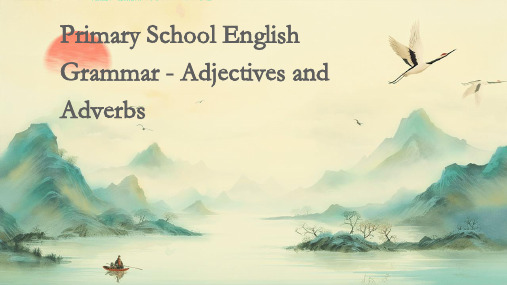
Add "-est" to the end of the adjective or use "most" + adjective for positive words. Example: "happy" -> "happiest", "most beautiful".
Types of Adjectives
总结词
品质、大小、年龄、形状、颜色、 国籍、材料
1. 品质形容词
描述事物内在特性的形容词,如 “beautiful”, “ugly”, “kind”.
2. 大小形容词
描述事物尺寸大小的形容词,如 “big”, “small”, “huge”.
Types of Adjectives
6. 国籍形容词
描述事物国籍或来源地的形容词 ,如“Italian”, “French”, “Australian”.
7. 材料形容词
描述事物材质的形容词,如
“wooden”,
“metal”,
“papery”.
The Usage of Adjectives
• 总结词:位置、顺序、单复数形式、比较级和最高级 • 位置:Adjectives usually come before the noun, e.g., "beautiful flower".
04
Practice and consolidation
Choose appropriate adjectives or adverbs to fill in the blanks
Superlative
Used to describe the best or the worst of a group. Example: "He is the tallest boy in the class."
小学英语语法知识详解之形容词与副词

小学英语语法知识详解之形容词与副词1. 形容词作定语,修饰名词或代词(1)形容词修饰名词,一般放在名词的前面。
例如:yellow desks, an interesting film.(2)如果形容词修饰以-thing/-body 等为词尾的复合不定代词时,要放在这些词之后。
如:something nice, nothing important 等。
2.形容词是谓语,位于系动词后面。
比如Tom looks very happy now. 汤姆现在看起来很开心。
The food tastes delicious. 这些食物尝起来很美味。
The weather is getting warmer and warmer. 天气变得越来越暖和了。
常见的系动词有:be, look, sound, smell, taste, feel, keep, get, turn, bee(表变化)等。
接下来看看什么是副词:副词(adverb,简写为 adv),是一种用来修饰行为动词、形容词、副词或整个句子的词,说明时间、地点、程度、方式等概念的词。
例如:well, badly, carefully, slowly 等。
(对于什么是副词,也同样是运用跟汉语相联系的办法,前面说形容词就是带“的”的词,那么副词就是带“地”或者“得”的词了,我们知道在汉语中带“地”的词后面都是接动词,也就意味着英语中汉语解释带“地”的词也是用来修饰动词的,这样既可以很好的理解什么是副词也能顺便把副词的基本用法了解了,一举两得。
对于带“得”的词,在汉语中一般是接形容词的,比如说:开心得不得了,可以看得出“开心”是形容词,而“不得了”是修饰开心的程度的,于是中文含义带有“得”的词就是副词,且是用来修饰形容词或者副词的程度的)副词的分类方式副词: 表示动作和状态的进行和存在方式、方法,如:carefully, suddenly, fast, well, politely,但friendly lovely, lonely, lively elderly, ugly 为形容词程度副词: 多用来修饰形容词和副词,如:very ,much,enough,almost,rather,so,too,still,quite地点副词:here ,there ,everywhere, anywhere, home, upstairs, downstairs 等时间副词:tomorrow, now, today, then, yesterday, tonight 等频度副词:always,usually,often,never,sometimes,seldom,once,rarely,hardly 等疑问副词:why, when, where, how(引导特殊疑问句) how often, how long ,how soon, how much, how many 等关系副词:when, where, why (用于定语从句)其他also,either,too,only,perhaps(对于疑问副词和关系副词,小学不用做要求,认识就行!)接下来看看副词的基本用法:(1)修改行为动词以显示动作是如何执行的。
小学阶段所有英语语法整理
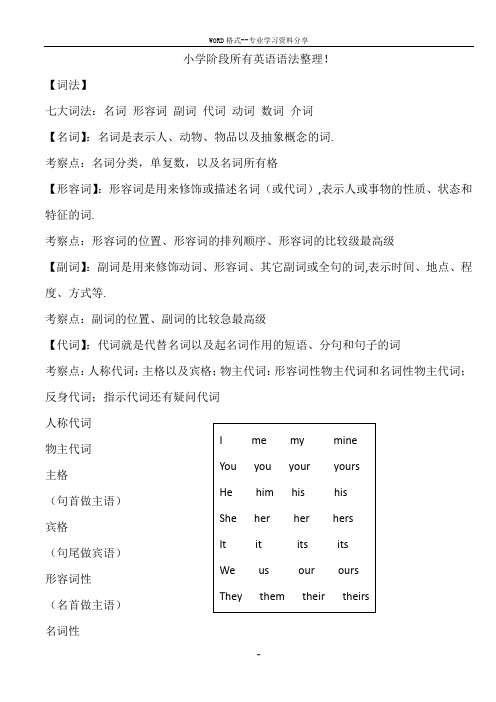
小学阶段所有英语语法整理!【词法】七大词法:名词形容词副词代词动词数词介词【名词】:名词是表示人、动物、物品以及抽象概念的词.考察点:名词分类,单复数,以及名词所有格【形容词】:形容词是用来修饰或描述名词(或代词),表示人或事物的性质、状态和特征的词.考察点:形容词的位置、形容词的排列顺序、形容词的比较级最高级【副词】:副词是用来修饰动词、形容词、其它副词或全句的词,表示时间、地点、程度、方式等.考察点:副词的位置、副词的比较急最高级【代词】:代词就是代替名词以及起名词作用的短语、分句和句子的词考察点:人称代词:主格以及宾格;物主代词:形容词性物主代词和名词性物主代词;反身代词;指示代词还有疑问代词人称代词主格(句首做主语)宾格(句尾做宾语)形容词性(名首做主语)名词性(句尾做宾语)【动词】:表示动作或状态的词叫做动词考察点:Be动词的用法、动词的变化规则、动词的分类Be 动词的用法:(1) Am--was Is --was Are--were 口诀:我用am, 你用are, is用在他她它,复数全用are。
(2) 肯定和否定句:I am (not) from London.My hair is (not) long.He is (not) a teacher.She is (not) in the dining room.Her eyes are (not) small.(3) 一般疑问句:Am I a Chinese? Yes, you are. No, you aren’t.Are they American? Yes, they are. No, they aren’t.Is the cat fat? Yes, it is. No, it isn’t.动词s的变化规则:1.一般情况下,直接加-s,如:cook-cooks, milk-milks2.以s. x. sh. ch. o结尾,加-es,如:guess-guesses, wash-washes, watch-watches, go-goes 3.以“辅音字母y”结尾,变y为i, 再加-es,如:study-studies动词加ing的变化规则:1.一般情况下,直接加ing,如:cook-cooking2.以不发音的e结尾,去e加ing,如:make-making, taste-tasting3.假如末尾是一个元音字母和一个辅音字母,双写末尾的辅音字母,再加ing,如:run-running, stop-stopping动词过去式变化规则:1.一般在动词末尾加-ed,如:work-worked , cook-cooked2.结尾是e加d,如:live-lived3.末尾只有一个元音字母和一个辅音字母的重读闭音节,应双写末尾的辅音字母,再加-ed如:stop-stopped4.以“辅音字母y”结尾的,变y为i,再加-ed,如:study-studied5.不规则动词过去式:am,is-was, are-were, do-did, see-saw, say-said, give-gave, get-got, go-went,come-came, have-had, eat-ate, take-took, run-ran, sing- sang, put-put,read-read, write-wrote, draw-drew, drink-drank, swim-swam, sit-sat【数词】:数词是表示数目多少或顺序先后的词.数词分为基数词和序数词.考察点:基数词、序数词(1)基数词:表示数目多少的数词叫做基数词.从1—10的基数词one,two,three,four,five,six,seven,eight,nine,ten.(2)序数词:表示顺序的数词叫做序数词.第1 first 1st 第2 second 2nd 第3 third 3rd第4 fourth 4th 第5 fifth 5th 第6sixth 6th第7 seventh 7th 第8 eighth 8th 第9 ninth 9th第10 tenth 10th【介词】:介词通常四用来表示它后面的名词(代词)或起名词作用的短语、从句与句中其它成分之间的关系.考察点:介词的分类及用法常见介词:(1)时间介词:at、in、on、before、after和from.(2)方位介词:on、in、at、under和behind等.(3)动向介词:into、out of、up、down、from、to、through和along (4)表示方式、手段的介词:by、with和in.(5)其它介词:for、about、with、in、of、like.【量词】:通常用来表示人、事物或动作的数量单位的词,叫做量词。
小学英语语法教案:形容词与副词
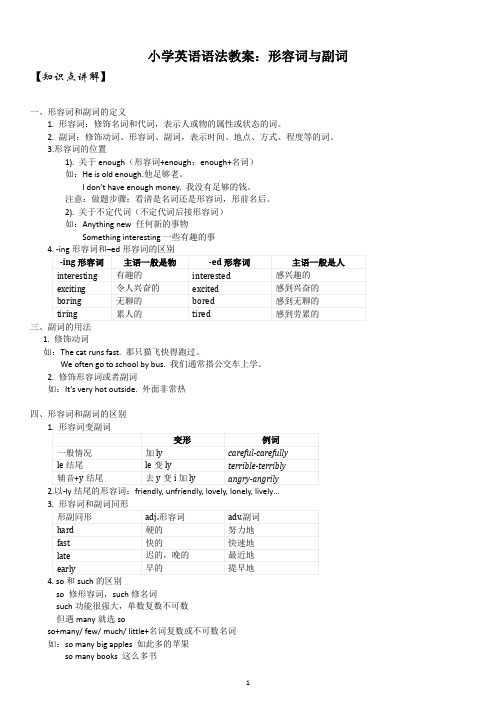
小学英语语法教案:形容词与副词【知识点讲解】一、形容词和副词的定义1. 形容词:修饰名词和代词,表示人或物的属性或状态的词。
2. 副词:修饰动词、形容词、副词,表示时间、地点、方式、程度等的词。
3.形容词的位置1). 关于enough(形容词+enough;enough+名词)如:He is old enough.他足够老。
I don’t have enough money. 我没有足够的钱。
注意:做题步骤:看清是名词还是形容词,形前名后。
2). 关于不定代词(不定代词后接形容词)如:Anything new 任何新的事物Something interesting一些有趣的事三、副词的用法1. 修饰动词如:The cat runs fast. 那只猫飞快得跑过。
We often go to school by bus. 我们通常搭公交车上学。
2. 修饰形容词或者副词如:It’s very hot outside. 外面非常热四、形容词和副词的区别2.以-ly结尾的形容词:friendly, unfriendly, lovely, lonely, lively…4. so和such的区别so 修形容词,such修名词such功能很强大,单数复数不可数但遇many就选soso+many/ few/ much/ little+名词复数或不可数名词如:so many big apples 如此多的苹果so many books 这么多书so few people 这么少的人so much money 那么多的钱so little milk 那么少的牛奶五、形容词副词的原级、比较级和最高级六、形容词副词的原级、比较级和最高级用法1. 原级形容词的本来形式就是形容词的原级。
1). “as…as”结构,表示“前者像后者一样”,A+do+as+adj./ adv. +as+B (+do).如:John is as tall as his brother. 约翰和他的哥哥一样高。
小学英语语法-形容词和副词

⼀、形容词的⽐较级 1、形容词⽐较级在句⼦中的运⽤:两个事物或⼈的⽐较⽤⽐较级,⽐较级后⾯⼀般带有单词than。
⽐较级前⾯可以⽤more, a little 来修饰表⽰程度。
than后的⼈称代词⽤主格(⼝语中可⽤宾格)。
2.形容词加er的规则: ⑴⼀般在词尾加er ; ⑵以字母e 结尾,加r ; ⑶以⼀个元⾳字母和⼀个辅⾳字母结尾,应双写末尾的辅⾳字母,再加er ; ⑷以“辅⾳字母+y”结尾,先把y变i,再加er 。
3.不规则形容词⽐较级: good-better, beautiful-more beautiful ⼆、副词的⽐较级 1.形容词与副词的区别 (有be⽤形,有形⽤be;有动⽤副,有副⽤动) ⑴在句⼦中形容词⼀般处于名词之前或be动词之后 ⑵副词在句⼦中最常见的是处于实义动词之后 2.副词⽐较级的变化规则基本与形容词⽐较级相同 (不规则变化:well-better, far-farther) 三、练习 ⼀、写出下列形容词或副词的⽐较级 old__________ young________ tall_______ long________ short________ strong________ big________ small_______ fat_________ thin__________ heavy______ light________ nice_________ good_________ beautiful__________________ low__________ high_________ slow_______ fast________ late__________ early_________ far_________ well_______ ⼆、根据句意填⼊单词的正确形式: 1. My brother is two years __________(old)than me. 2. Tom is as ________(fat) as Jim. 3. Is your sister __________(young) than you? Yes,she is. 4. Who is ___________(thin),you or Helen? Helen is. 5. Whose pencil-box is __________(big),yours or hers? Hers is. 6. Mary’s hair is as __________(long) as Lucy’s. 7.Ben ______ (jump) ________ (high) than some of the boys in his class. 8.________ Nancy sing __________ (well) than Helen? Yes, she _____. 9.Fangfang is not as _________ (tall) as the other girls. 10.My eyes are __________(big) than ________ (she).. 11.Which is ___________(heavy),the elephant or the pig? 12.Who gets up _________(early),Tim or Tom? 13._____the girls get up_______(early) than the boys?No,they______. 14. Jim runs _____(slow). But Ben runs _____(slow). 15.The child doesn’t______(write) as ____(fast) as the students. 三、翻译句⼦: 1、谁⽐Jim年纪⼤?是你。
小学英语语法——形容词与副词知识点讲解+练习

形容词和副词一、形容词、副词概述1、形容词定义:形容词(adjective),简称adj,用来修饰名词或代词,表示人或事物的性质、状态和特征。
2、副词定义:副词(adverb),简称adv,用来修饰动词、形容词或副词,表示时间、频率、范围、语气、程度等。
二、形容词、副词考点纵览三、综合练习( ) 1. How beautifully she sings! I have never heard _____ voice.A. a betterB. a bestC. the betterD. the best ( ) 2. She looks very _____ but I can’t remember her name.A. similarB. familiarC. friendlyD. strange ( ) 3. Children all looked _____ at the broken model plane and felt quite _____.A. sad; sadB. sadly; sadlyC. sad; sadlyD. sadly; sad( ) 4. The child dreamed that he had once lived in a _______ house in the forest.A. wooden pretty littleB. little pretty woodenC. pretty little woodenD. wooden little pretty( ) 5. ---Which team is _______ to win the game?---I don’t know, but I’ve found _______ for ours to win.A. probable; it unlikelyB. likely; it possibleC. possible; it possibleD. likely; it possibly( ) 6. With the development of the Internet, _______ communication is done by regular mail.A. lessB. moreC. littleD. few( ) 7. ---If you don’t like the red coat, take the blue one.---OK, but do you have ______ size in blue? This one’s a bit tight for me.A. a bigB. a biggerC. the bigD. the bigger( ) 8. If there were no examinations, we should have ______ at school.A. the happiest timeB. a more happier timeC. much happiest timeD. a much happier time( ) 9. This dress is prettier, but it costs ______ that one.A. twice more thanB. twice as much asC. as much twice asD. twice so much as( ) 10.________students are required to take part in the boat race.A. Ten strong young ChineseB. Ten Chinese strong youngC. Chinese ten young strongD. Young strong ten Chinese( ) 11. Allen had to call a taxi because the box was ____to carry all the way home.A. much too heavyB. too much heavyC. heavy too muchD. too heavy much( ) 12. Our neighbor has ________ours.A. as a big house asB. as big a house asC. the same big house asD. a house the same big as( ) 13. We were in ________when we left that we forgot the airline tickets.A. a rush so anxiousB. a such anxious rushC. so an anxious rushD. such an anxious rush( ) 14. ---I was riding along the street and all of a sudden, a car cut in and knocked me down.---You can never be ________careful in the street.A. muchB. veryC. soD. too( ) 15. ---You don’t look very ________.Are you ill?---No,I’m just a bit tired.A. goodB. wellC. strongD. healthy( ) 16. Four of Robert’s children were at the party,including ________, Luke.A. the eldestB. an oldest oneC. the oldD. an old one( ) 17. Many students signed up for the ________race in the sports meeting to be held next week.A. 800-metre-longB. 800-metres-longC. 800 metre lengthD. 800 metres length( ) 18. It’s always difficult being in a foreign country,________if you don’t speak the language.A. extremelyB. naturallyC. basicallyD. especially。
小学英语语法 形容词副词

腾飞辅导中心小学英语语法(第22期)第三讲形容词与副词Name Mark★重点讲解一、形容词:形容词就是用来修饰物体得形状、大小、长度、属性、特点得词。
1。
一般位于名词前,做“ 前置定语” 。
Ihave a busyday、我忙了一天、She isa famous scientist。
2.放在be动词得后面,被称为“系表结构” 、如:He is clever. She is beautiful.3、当几个形容词或形容词与名词同时修饰一个名词时,必须按照正确得排列顺序,即:大小---形状---颜色--—质地、如:abig yellow banana a whiteround stone bench4、表示国籍得几个形容词,还可以用作名词,但意义上有所区别。
如:a Chinese/Japanese boy speak Chinese/Japanese5、形容词修饰不定代词something, anything等时,需要置于其后。
如:I have somethingimportant totell you、There issomething wrong withyou.二、副词:就是说明时间、地点、程度、方式等概念得词。
1、副词得分类时间副词如:now, usually,often,always,sometime,yesterday等。
地点副词如:here, there, everywhere等。
(其前不能加介词,如:go there/ e here)方式副词如:quietly,slow ly,quickly,careful ly等。
( ““怎样地” )程度副词如:very,much, quite(完全地,十分地), too(太)等。
2。
副词得用法:主要用来修饰动词得、如:He plays basketballwell、He jump shigh、三、形容词、副词得等级:原级、比较级与最高级、1、原级得用法肯定句:主语+ be动词+as + 原级+as 。
专题05 形容词与副词_备战2021年小升初英语必考语法和题型(解析版)
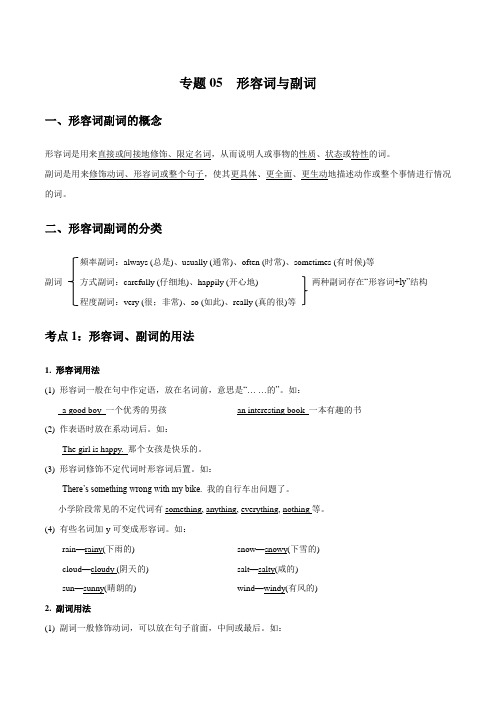
专题05 形容词与副词一、形容词副词的概念形容词是用来直接或间接地修饰、限定名词,从而说明人或事物的性质、状态或特性的词。
副词是用来修饰动词、形容词或整个句子,使其更具体、更全面、更生动地描述动作或整个事情进行情况的词。
二、形容词副词的分类频率副词:always (总是)、usually (通常)、often (时常)、sometimes (有时候)等副词方式副词:carefully (仔细地)、happily (开心地) 两种副词存在“形容词+ly”结构程度副词:very (很;非常)、so (如此)、really (真的很)等考点1:形容词、副词的用法1. 形容词用法(1) 形容词一般在句中作定语,放在名词前,意思是“… …的”。
如:a good boy 一个优秀的男孩an interesting book 一本有趣的书(2) 作表语时放在系动词后。
如:The girl is happy. 那个女孩是快乐的。
(3) 形容词修饰不定代词时形容词后置。
如:There’s something wrong with my bike.我的自行车出问题了。
小学阶段常见的不定代词有something, anything, everything, nothing等。
(4) 有些名词加-y可变成形容词。
如:rain—rainy(下雨的) snow—snowy(下雪的)cloud—cloudy (阴天的) salt—salty(咸的)sun—sunny(晴朗的) wind—windy(有风的)2. 副词用法(1) 副词一般修饰动词,可以放在句子前面,中间或最后。
如:They live happily.他们幸福地生活着。
(happily 快乐地,幸福地,修饰动词live)They are listening to the teacher carefully. 他们在认真地听老师讲。
(carefully 认真地,修饰动词listen)温馨提示:连系动词不用副词修饰,直接加形容词作表语。
形容词和副词 小学英语语法
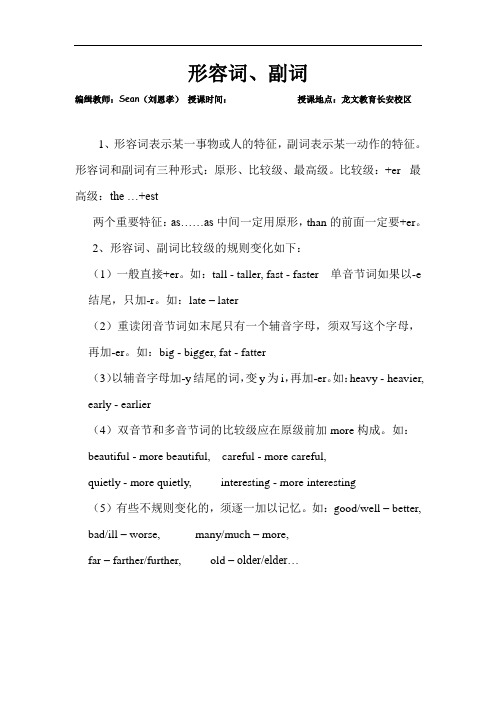
形容词、副词编缉教师:Sean(刘恩孝)授课时间:授课地点:龙文教育长安校区1、形容词表示某一事物或人的特征,副词表示某一动作的特征。
形容词和副词有三种形式:原形、比较级、最高级。
比较级:+er 最高级:the …+est两个重要特征:as……as中间一定用原形,than的前面一定要+er。
2、形容词、副词比较级的规则变化如下:(1)一般直接+er。
如:tall - taller, fast - faster 单音节词如果以-e 结尾,只加-r。
如:late – later(2)重读闭音节词如末尾只有一个辅音字母,须双写这个字母,再加-er。
如:big - bigger, fat - fatter(3)以辅音字母加-y结尾的词,变y为i,再加-er。
如:heavy - heavier, early - earlier(4)双音节和多音节词的比较级应在原级前加more构成。
如:beautiful - more beautiful, careful - more careful,quietly - more quietly, interesting - more interesting(5)有些不规则变化的,须逐一加以记忆。
如:good/well – better, bad/ill – worse, many/much – more,far – farther/further, old –older/elder…形容词、副词练一练:全卷满分:拟题人:Sean(刘恩孝)拟题时间:1、写出下列形容词、副词的比较级。
big good longtall old short t hin heavy youngfat light stronghigh far lowearly late wellfast slow2、用括号内所给单词的适当形式填空。
1) I can swim as _______ ( fast ) as the fish, I think.2) Look! His hands are _______ ( big ) than mine.3) I think you do these things_______ ( well ) than your classmates.4) Whose bag is _______ ( heavy ), yours or mine?5) Does Jim run as _______(slow ) as David? Yes, but Mikeruns_______ ( slow ) than them.6) You have seven books, but I have _______ ( many ) than you.I have ten.7) I jump _______ ( far ) than some of the boys in my class.8) I’m very_______ ( thin ), but she’s _______ ( thin ) than me.9) It gets _______and_______ ( warm ) when spring comes here.。
小学英语语法之形容词和副词
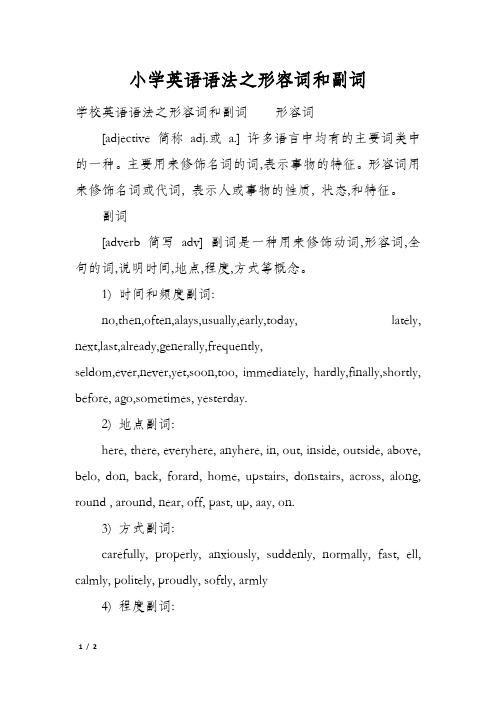
小学英语语法之形容词和副词学校英语语法之形容词和副词形容词[adjective 简称adj.或a.] 许多语言中均有的主要词类中的一种。
主要用来修饰名词的词,表示事物的特征。
形容词用来修饰名词或代词, 表示人或事物的性质, 状态,和特征。
副词[adverb简写adv] 副词是一种用来修饰动词,形容词,全句的词,说明时间,地点,程度,方式等概念。
1) 时间和频度副词:no,then,often,alays,usually,early,today, lately, next,last,already,generally,frequently,seldom,ever,never,yet,soon,too, immediately, hardly,finally,shortly, before, ago,sometimes, yesterday.2) 地点副词:here, there, everyhere, anyhere, in, out, inside, outside, above, belo, don, back, forard, home, upstairs, donstairs, across, along, round , around, near, off, past, up, aay, on.3) 方式副词:carefully, properly, anxiously, suddenly, normally, fast, ell, calmly, politely, proudly, softly, armly4) 程度副词:much,little, very,rather,so,too,still, quite, perfectly, enough, extremely, entirely,almost, slightly.5) 疑问副词:ho, hen, here, hy.6) 关系副词:hen, here, hy.7) 连接副词:therefore,moreover,hoever,otherise,then.。
小学英语语法副词形容词

一、形容词、副词的词形区别形容词=名词+y / ly / ous / ive / fulEg:wind+y=windy;love+ly=lovely;danger+ous=dangerous;expense+ive=expensive;care+ful=careful副词=形容词+lyEg:careful+ly=carefully二、形容词、副词用法区别记忆口诀:形名动副系形副形1、形名——形容词修饰名词Eg:a young girl2、动副——副词修饰动词Eg:run quickly3、系形——系动词后面跟形容词Eg:is lovely4、副形:副词修饰形容词Eg:very good三、形容词如何的排序?有一个房间,有很多的修饰限定词,如何给它们排序?按照如下顺序:美丑-大小-形状-新旧-颜色-国籍-材质-用途记忆口诀:美小圆旧黄,法国木书房A beautiful small round old yellow French wooden study room四、形副同形词有哪些?1、Well形容词性意思:身体好的副词性意思:好地2、Fast形容词性意思:快的副词性意思:快地3、Early形容词性意思:早的副词性意思:早早地4、Hard形容词性意思:难的,硬的副词性意思:勤奋地衍生词:Hardly 几乎不5、Late形容词性意思:晚的副词性意思:晚地衍生词:Lately 最近6、Near形容词性意思:近的副词性意思:近地衍生词:Nearly 几乎7、High形容词性意思:高的副词性意思:高地衍生词:Highly 高度地五、比较级和最高级词的比较级和最高级变化规则。
小学英语重点语法知识“形容词副词”汇总(附练习)

小学英语重点语法知识“形容词副词”汇总(附练习)小学英语形容词副词及其各种用法是英语学习过程中的一个重要模块,但是,在孩子们的眼中,形容词、副词是最难区分的,给人的感觉很模糊,可是如何的区别他们呢?他们都有什么特殊用法吗?我们就来讲讲“形容词、副词”的用法吧!形容词、副词的区别形容词=名词+y / ly / ous / ive / fulEg:wind+y=windy;love+ly=lovely;danger+ous=dangerous;expense+ive=expensive;care+ful=careful副词=形容词+lyEg:careful+ly=carefully形容词、副词用法区别记忆口诀1、形名——形容词修饰名词Eg:a young girl2、动副——副词修饰动词Eg:run quickly3、系形——系动词后面跟形容词Eg:is lovely4、副形:副词修饰形容词Eg:very good形容词如何的排序?有一个房间,有很多的修饰限定词,如何给它们排序?按照如下顺序:美丑-大小-形状-新旧-颜色-国籍-材质-用途记忆口诀:美小圆旧黄,法国木书房A beautiful small round old yellow French wooden study room形副同形词有哪些?1、Well形容词性意思:身体好的副词性意思:好地2、Fast形容词性意思:快的副词性意思:快地3、Early形容词性意思:早的副词性意思:早早地4、Hard形容词性意思:难的,硬的副词性意思:勤奋地衍生词:Hardly 几乎不5、Late形容词性意思:晚的副词性意思:晚地衍生词:Lately 最近6、Near形容词性意思:近的副词性意思:近地衍生词:Nearly 几乎7、High形容词性意思:高的副词性意思:高地衍生词:Highly 高度地比较级和最高级1.词的比较级和最高级变化规则。
小学英语语法 形容词副词

腾飞辅导中心小学英语语法(第22期)第三讲形容词和副词Name Mark★重点讲解一、形容词:形容词是用来修饰物体的形状、大小、长度、属性、特点的词。
1.一般位于名词前,做“ 前置定语” 。
I have a busy day. 我忙了一天。
She is a famous scientist.2.放在be动词的后面,被称为“ 系表结构” 。
如:He is clever. She is beautiful.3.当几个形容词或形容词和名词同时修饰一个名词时,必须按照正确的排列顺序,即:大小--- 形状--- 颜色--- 质地。
如:a big yellow banana a white round stone bench4.表示国籍的几个形容词,还可以用作名词,但意义上有所区别。
如:a Chinese /Japanese boy speak Chinese / Japanese5.形容词修饰不定代词something, anything等时,需要置于其后。
如:I have something important to tell you.There is something wrong with you.二、副词:是说明时间、地点、程度、方式等概念的词。
1.副词的分类时间副词如:now, usually, often, always, sometime, yesterday等。
地点副词如:here, there, everywhere等。
(其前不能加介词,如:go there / come here)方式副词如:quiet ly, slow ly,quick ly, careful ly等。
(““怎样地” )程度副词如:very, much, quite(完全地,十分地), too(太)等。
2.副词的用法:主要用来修饰动词的。
如:He play s basketball well.He jump s high.三、形容词、副词的等级:原级、比较级和最高级。
小学英语语法形容词,副词的用法总结整理归纳

eg:He is taller than me. 他比我高。
The girl is more beautiful than before. 这个女孩比以前漂亮多了。
Jack runs faster than his brother. 杰克跑得比他哥哥快。
②“which/who is + 形容词/副词比较级, A or B ?”
① 时间副词一般放在句尾或句首,有时可以放在动词前面。
eg: I often do exercises in the morning. 我经常在早上做操
Tomorrow many people will go for a picnic.明天很多人将要去野餐。
② 地点副词一般放在句尾,有时可以放在句首(如 here/there)。
always(一直),usually(通常),often(经常), sometimes(有时候)never(从不),once(一次), twice(两次)
疑
问
how(如何),where(在哪里),when(什么时候),
主要是用来构成特殊疑问句。
副
why(为什么)
词
三、形容词/副词的位置 (1)形容词的位置
意思为“A 和 B,哪一个更……”。
eg:which is bigger,the sun or the moon ?
哪一个更大,地球还是月亮?
Who is cleverer,Lily or Lucy ?
谁更聪明,莉莉还是露西?
③“the + 形容词比较级 + of + 名词”,意思为“两者之间较……的一个”。
小学语法—形容词和副词
一、形容词/副词的定义
形容词:用来修饰名词或者部分代词的词。形容词一般翻译成“……的” 副词:修饰动词、形容词、其他副词或全句的词,表明方式,时间,地点、程度 等。副词一般翻译成“……地/得” eg:She is a beautiful girl.他是一个漂亮的女孩。 (形容词修饰名词)
小学语法---形容词和副词

小学语法---形容词和副词未来之星——小学语法——形容词和副词形容词和副词是英语中常用的词性,它们分别用来修饰名词和动词,下面将详细介绍它们的概念和用法。
一、形容词、副词的概念形容词是用来描述人或事物的性质、特征和状态的词语,通常用来修饰名词或代词。
副词是用来说明事情发生的时间、地点、原因、方式等含义的词语,通常用来修饰动词或整个句子。
二、形容词、副词的用法1.形容词作定语形容词一般用来修饰名词或代词,放在它们的前面,表示“……的”意思。
例如:a nice watch(一只漂亮的手表)an empty box(一个空箱子)a clever boy(一个聪明的男孩)a beautiful girl(一个美丽的女孩)us food(可口的食物)an interesting book(一本有趣的书)a blue car(一辆蓝色的小汽车)an exciting speech(一次令人兴奋的演讲)注意:当形容词修饰不定代词(someone。
somebody。
something。
anyone。
anybody。
anything。
nobody。
nothing)时,需要置于其后。
例如:something important(重要的事情)nothing interesting(没有什么有趣的)2.形容词作表语有些形容词只能作表语,放在系动词之后,例如:XXX.(这些花是蓝色的。
)Bob looks smart today.(今天XXX看上去很精神。
)还有一些形容词只能作表语,放在系动词之后,例如:XXX等。
The boy is asleep.(男孩正在睡觉。
)Lucy and Lily look XXX.(XXX和XXX长得很像。
)XXX.(她的母亲病了。
)3.形容词做宾语补足语形容词还可以作为宾语补足语,放在宾语之后,用来补充说明宾语的状态、特征等。
通常用于make / paint / keep / find / want / like等动词后接名词或代词作宾语。
小学英语语法——形容词副词
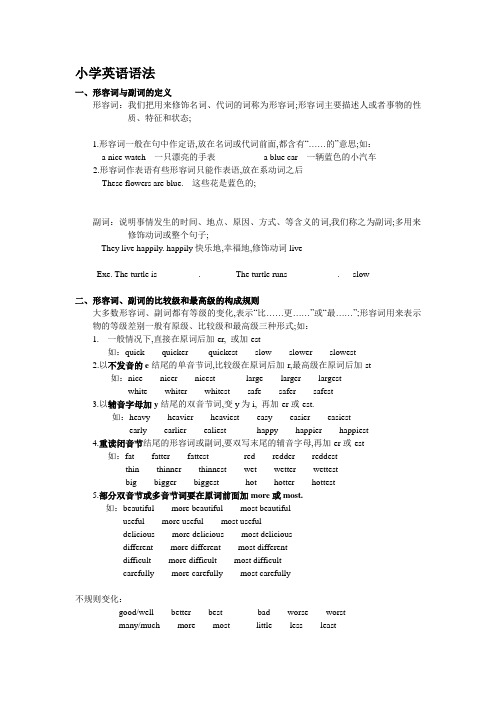
小学英语语法一、形容词与副词的定义形容词:我们把用来修饰名词、代词的词称为形容词;形容词主要描述人或者事物的性质、特征和状态;1.形容词一般在句中作定语,放在名词或代词前面,都含有“……的”意思;如:a nice watch 一只漂亮的手表 a blue car 一辆蓝色的小汽车2.形容词作表语有些形容词只能作表语,放在系动词之后These flowers are blue. 这些花是蓝色的;副词:说明事情发生的时间、地点、原因、方式、等含义的词,我们称之为副词;多用来修饰动词或整个句子;They live happily. happily快乐地,幸福地,修饰动词liveExe. The turtle is _________. The turtle runs ___________. slow二、形容词、副词的比较级和最高级的构成规则大多数形容词、副词都有等级的变化,表示“比……更……”或“最……”;形容词用来表示物的等级差别一般有原级、比较级和最高级三种形式;如:1.一般情况下,直接在原词后加-er, 或加-est如:quick------quicker-------quickest slow------slower------slowest2.以不发音的e结尾的单音节词,比较级在原词后加-r,最高级在原词后加-st如:nice------nicer------nicest large------larger------largestwhite------whiter------whitest safe------safer------safest3.以辅音字母加y结尾的双音节词,变y为i, 再加-er或-est.如:heavy------heavier------heaviest easy------easier------easiestearly------earlier------ealiest happy------happier------happiest4.重读闭音节结尾的形容词或副词,要双写末尾的辅音字母,再加-er或-est如:fat------fatter------fattest red------redder------reddestthin------thinner------thinnest wet------wetter------wettestbig------bigger------biggest hot------hotter------hottest5.部分双音节或多音节词要在原词前面加more或most.如:beautiful------more beautiful------most beautifuluseful------more useful------most usefuldelicious------more delicious------most deliciousdifferent------more different------most differentdifficult------more difficult------most difficultcarefully------more carefully------most carefully不规则变化:good/well------better------best bad------worse------worstmany/much------more------most little------less------leastfar------farther------farthest 指距离的远近far------further------furthest 表示程度上更进步old------older------oldest 表示年纪大old------elder------eldest 表示长幼关系三、形容词、副词比较级的用法表示两者间的比较用比较级;其常见句式有:1.“A + be +形容词比较级+ than + B” 意思为“A比B更……”;如:My pen is cheaper than yours .Tom runs faster than you.注意:①在含有连词than的比较级中,前后的比较对象必须是同一范畴,即同类事物之间的比较;②在比较级前面使用much,表示程度程度“强得多”;如:A watermelon is much bigger than an apple.③ very, quite一般只能修饰原级,不能修饰比较级;四、形容词、副词的最高级的用法形容词、副词的最高级形式主要用来表示三者或三者以上人或事物的比较,表示“最……”的意思;句子中有表示范围的词或短语;如:of the three, in our class等等;如:He is the tallest in our class. 他在我们班里是最高的;五、注意形容词最高级前一定要有定冠词the,而副词最高级前则不需要;。
小学英语语法形容词和副词详细讲解

编辑ppt
10
2)形容词在句子中也常放在系动词之后,名 词+系动词+形容词,如:
These flowers are red.这些花是红色的。(形 容词red在句中放在系动词be之后。)
Bob looks smart today.今天鲍勃看上去很精神。
3 形容词与表示“长、宽、高、重、老、 距离”的词连用时,常放在后面。 I am 1.60 meters tall.我1米60。 She is 12 years old.我12岁。
23
Tom
Li Lei
Jim
Li Lei is taller than Tom. Jim is the tallest of all.
¥30
¥20
¥10
The yellow coat is cheaper than the purple one.
The brown coat is the ch编辑epaptpest of the three. 24
星期日 星期一 星期二 星期三 星期四 星期五 星期六
编辑ppt
6
2) 有关国家和民族的形容词加上定冠词指这个民族的整体,与动词的复数连用,如 the British,the English, the French,the Chinese 等。例如:
The English have wonderful sense of humor. 英国人颇有幽默感。
主语 + be + the + 最高级 + of / in…..
编辑ppt
26
young
cheap
¥30
tall
Tom
¥20
编辑ppt
- 1、下载文档前请自行甄别文档内容的完整性,平台不提供额外的编辑、内容补充、找答案等附加服务。
- 2、"仅部分预览"的文档,不可在线预览部分如存在完整性等问题,可反馈申请退款(可完整预览的文档不适用该条件!)。
- 3、如文档侵犯您的权益,请联系客服反馈,我们会尽快为您处理(人工客服工作时间:9:00-18:30)。
腾飞辅导中心小学英语语法(第22期)第三讲形容词与副词Name Mark★重点讲解一、形容词:形容词就是用来修饰物体得形状、大小、长度、属性、特点得词。
1。
一般位于名词前,做“ 前置定语” 。
Ihave a busyday、我忙了一天、She is a famous scientist。
2.放在be动词得后面,被称为“系表结构” 、如:He is clever. She is beautiful.3、当几个形容词或形容词与名词同时修饰一个名词时,必须按照正确得排列顺序,即:大小---形状---颜色--—质地、如:abig yellow banana a whiteround stone bench4、表示国籍得几个形容词,还可以用作名词,但意义上有所区别。
如:a Chinese/Japanese boy speak Chinese/Japanese5、形容词修饰不定代词something, anything等时,需要置于其后。
如:I have somethingimportant totell you、There issomething wrong withyou.二、副词:就是说明时间、地点、程度、方式等概念得词。
1、副词得分类时间副词如:now, usually,often,always,sometime,yesterday等。
地点副词如:here, there, everywhere等。
(其前不能加介词,如:go there/ e here)) 方式副词如:quietly,slow ly,quickly,careful ly等。
( ““怎样地” 程度副词如:very,much, quite(完全地,十分地), too(太)等。
2。
副词得用法:主要用来修饰动词得、如:He plays basketballwell、He jump shigh、三、形容词、副词得等级:原级、比较级与最高级、1、原级得用法肯定句:主语+ be动词+as + 原级+as 。
.、.。
、,表示“与…一样,如:Surfing isas interesting asswimming、否定句:主语+ be动词+not so/as+ 原级+as.、。
.、,表示“与…不一样,如: Surfing is not so/ as interesting asswimming2。
比较级:两个人或物体之间得相对比较、通常用在两个物体之间用than来连接。
(1)句式结构:主语+be动词+比较级+ than+。
、..。
,如:English ismore important than Japanese, I think. (有than一定有比较级)Which do you like better,this one or thatone?(没有than也可以有比较级) (2)比较级得用法:①比较级and比较级,如:Hebees fatter andfatter、②moreandmore+ 原级“、.。
、.。
越来越.、。
.",如:Our country is being more and morebeautiful.③ The+比较级…。
. , the +比较级… 。
、、“… 越…, 越…”The more, thebetter、3、最高级:就是三个或三个以上得物体之间得相互比较。
(1)句式结构:主语+be动词+ 最高级、.、.、。
,如:Amy is the mostbeautiful girl inmyclass、(形容词最高级前要有the)He runs fastestin therunning match、(副词前最高级前得the省略)(2)最高级得用法:① (the)最高级+ 比较范围…Jim is thetallestin hisclass。
Jimis the tallestof thethree、②最高级… , A , B or C ?Which is the farthest, thetrainstation, the busstationor theairport?③主语+be动词+ one of the+ 最高级+名词复数Xi’an is oneof the oldestcities inChina、★补充:比较级前可以有一个表示程度得词:如 a littlerather much a lot fareven any等Heismuch better today。
Frank iseven strongerthan his father.四、形容词与副词得变化关系1.大多数副词就是用形容词加后缀-ly构成得、Eg:quick-- quickly slow-—slow ly brave —— bravely2.以—y结尾得形容词,现将y改成i,再加—ly。
Eg:happy----—happily angry-—-—-angrily3.有些副词与形容词形式相同。
Eg:late, early, high, long, fast,friendly补充:good得副词就是well,但就是well也有形容词得意义,表示身体状况好,如:I‘mwell。
貌似副词得形容词:friendly友好得;lovely可爱得五、形容词、副词比较级与最高级变化规则情况变化规则举例一般单音节词/少数多音节词直接在词尾加—er或—esttall-taller - tallest clean-cleaner –cleanestsmall-smaller-smallestclever—cleverer-cleverest strong-stronger-strongestlong—longer—longest young—younger-youngest以e结尾得单音节词加-r或—st large---larger –largest safe–safer–safestlate--- later ——-latest fine-–finer–finest wide-wider-widest以“辅音字母+y”结尾得词变y为i再加-er或—est early–earlier-earliest。
easy -easier–easiest heavy—heavier-heaviesthappy–happier–happiestdry-- drier—- driest以重读闭音节单音节结尾,且末尾只有一个辅音字母得词双写末尾得辅音字母,再加—er 或—esthot –hotter--hottest thin-–thinner-—thinnestbig –bigger –biggest wet– wetter– wettestfat-—fatter-—fattest多音节与大部分双音节词在原级前加more/ mostimportant——more important —- most importantbeautiful -— morebeautiful--most beautifulinteresting——more interesting -—most interesting不规则变化(重要,常考)原级比较级最高级good/well betterbestbad/ill worseworst many/much more most littleless leastfar farther/ farthest/★做中学一、写出下列形容词与副词得比较级与最高级形式1。
long __________ ___________2。
wide__________________________3、fat______________________4、strong___________ _____________5。
bright ________ ___________ 6。
young_________________________7. big __________ ___________8.easy_________________________9。
kind_________________________ 10。
small ____________ _____________ 11。
bad ____________ _____________12、good_________________________13、heavy _________________________ 15、ill ____________ _____________16、old ____________ _____________二、用所给词得正确形式填空1. Of the two girls,IfindLucy the___________(clever)、2、Gold(黄金) is ______(little) useful than iron(铁)。
3。
My sister istwo years_______(old) than I。
ents have four daughters,and sheis the_________(young) child.4、John’s par5。
The _________ (cheap) bagsare not usually the worst ones。
6。
The boy is not so ______(interesting) ashis brother、8、Dick sings _____ (well), she sings _________ (well)than John, but Mary sings________(well)in her class、9.She will bemuch _________ (happy)inher mewhouse。
★过关训练一、选择填空1、The line is____ than thatone.A。
more longer B、not longer C、muchlonger D。
manymore longer2、The book is____of the two.A。
thinner B.the thinner C. more thinner D、the thinnest3。
She looks _____than she does、A。
the more older B. very older C. mucholder D. more older4、Thegarden isbeing ______.A. more beautiful and moreB、morebeautiful and beautifulC. more andmore beautiful D。
